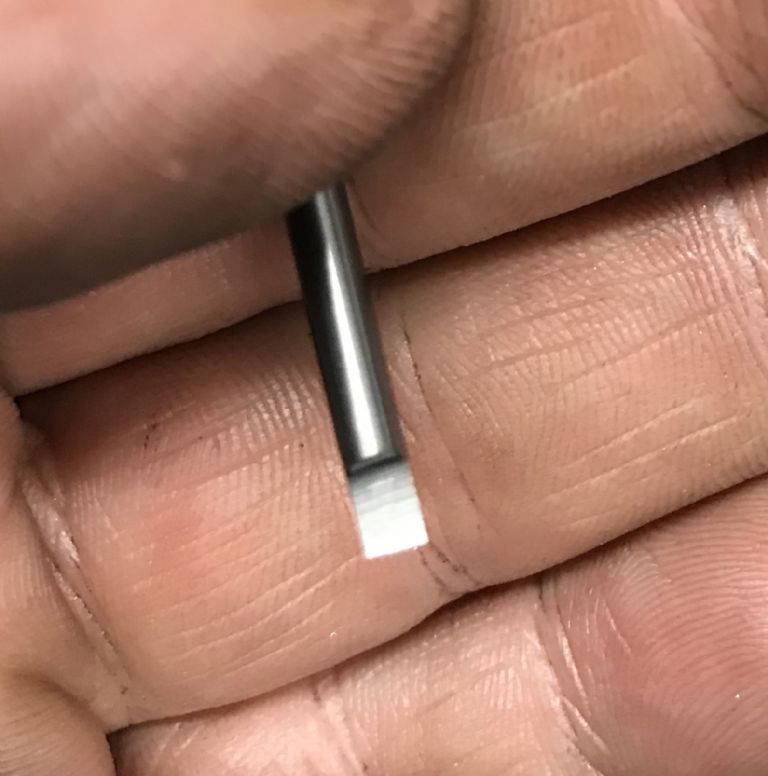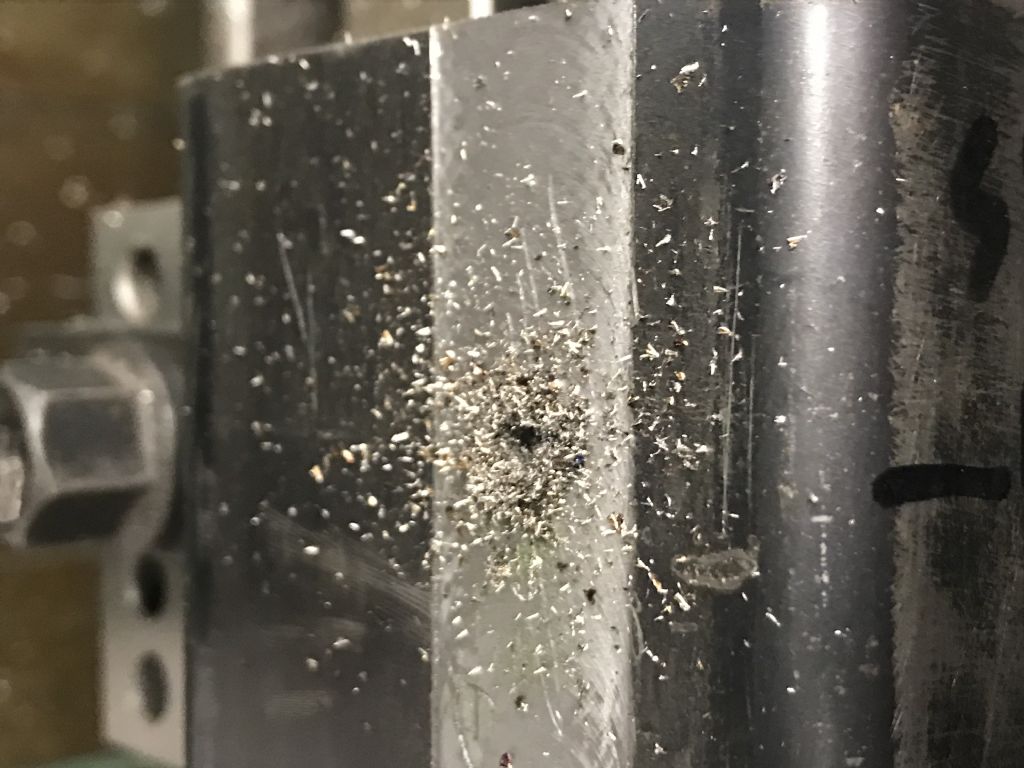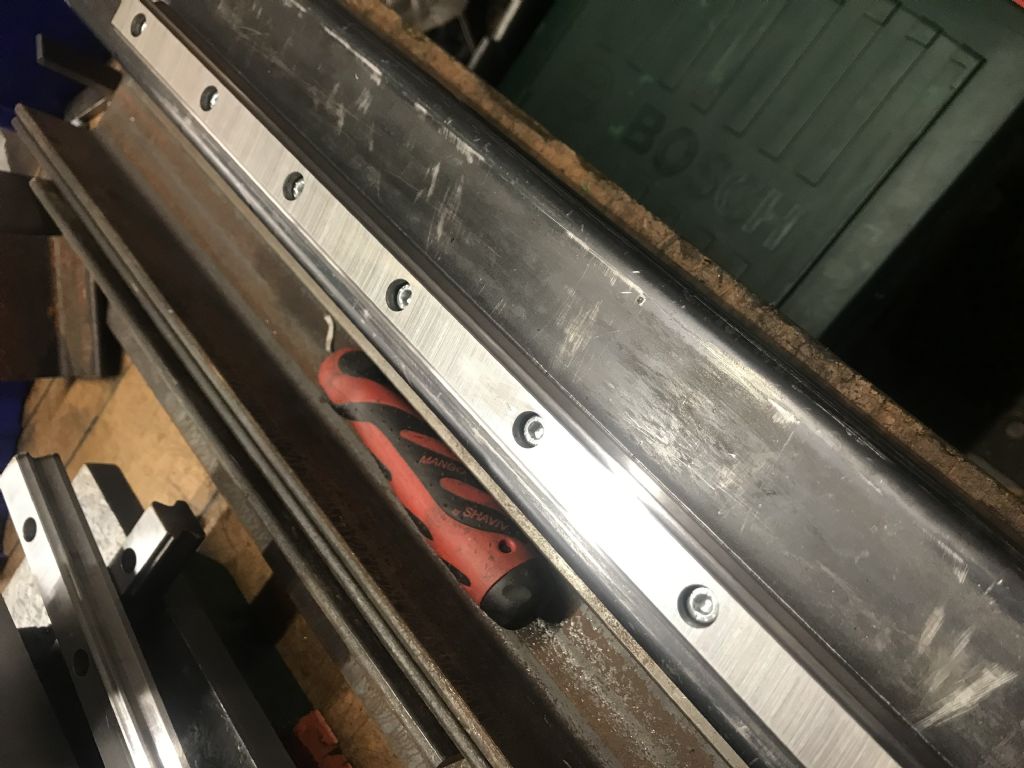Sigh, practicing a skill I would rather not need
| Dave S | 17/04/2022 16:54:50 |
| 433 forum posts 95 photos | I have just snapped another M5 tap on my current project. <Sigh> Now I get to practice tap removal again. That is a skill I wish I didn’t get the opportunities to practice.
Dave
|
| Roger Best | 17/04/2022 16:59:58 |
406 forum posts 56 photos | Noooooo. |
| Mike Poole | 17/04/2022 18:12:39 |
3676 forum posts 82 photos | Are you tapping a difficult material or just suffering from a wobble that snaps the tap? A difficult material can be made a bit easier by drilling for a less than full thread depth. To combat the wobbles it can help to use a drilling machine with a spring loaded centre to keep the tap true to the work, a mill or the lathe can also be used to provide the same service or a universal pillar tool if you have one. Mike |
| old mart | 17/04/2022 18:25:55 |
| 4655 forum posts 304 photos | The trouble is that good taps come in different guises, to optimise different materials. I had to tap a 3mm hole in Densimet which is a Tungsten Cobalt alloy and bought a green ring tap intended for hard material. It did not want to do the job, despite being new and industrial quality. I looked through the box of small metric taps and found one that tapped the hole easily and it looked very second hand. I might have been better off getting a tap intended for aluminium. For hand tapping, you could make a tap guide that keeps the tap square to the hole, just a piece of metal with a hole drilled using a drill press or mill that the tap can just pass through. |
| Rik Shaw | 17/04/2022 18:29:49 |
1494 forum posts 403 photos | I have found that you are more likely to break a tap if it is blunt. I use good quality British made HSS (Presto, Dormer etc) but even these get blunt eventually. As for carbon steel jobbies - I would not give them house room even though some swear by them. Rik |
| Bill Phinn | 17/04/2022 19:11:18 |
| 1076 forum posts 129 photos | There are many reasons for tap breakage [here are just a few of them], but the most over-arching reason in hand-tapping is insensitivity on the part of the operator to what the tap is actually "going through" at all times during its use. You have to develop a feel for the tap in the material and know whether the tap is liking or disliking what you are doing with it. Invaluable practice can be obtained without great expense by tapping many consecutive deep blind holes with small taps on a range of scrap pieces of material. |
| Dave S | 17/04/2022 19:12:48 |
| 433 forum posts 95 photos | HSS from a reputable source. Nearly new, probably done under a dozen holes. Just one of those things I guess, no difference in the procedure from how I’d normally work. Some pics: Carbide D bit: Peck drill 1 thou at a time… Then pick out the remains: Rescued, thread ok and part usable. Dave
|
| Peter Ellis 5 | 17/04/2022 19:46:17 |
| 110 forum posts 11 photos | Hi Where did your carbide D bit come from ? (asking for a friend !) Cheers
Peter |
| Dave S | 17/04/2022 20:20:44 |
| 433 forum posts 95 photos | I made it from a snapped PCB drill. I have a Deckel S0 grinder. Dave |
| Bob Worsley | 17/04/2022 21:10:24 |
| 146 forum posts | Is it just me or do the flutes look more than a little uneven?
|
| DMB | 17/04/2022 22:13:24 |
| 1585 forum posts 1 photos | My take on this caper - 1. I never buy 2 nd hand taps ( or drills) Only new, sharper. 2 Always use methods of guidance as outlined above by others. 3 Try to avoid tapping blind holes, only through holes. 4. If blind hole tapping unavoidable, don't use grease or any kind of tapping sludge, however good it's supposed to be. Only use thin oil. Much easier to wash out swarf from the bottom of the hole with say, paraffin. 5. If in any doubt, use next larger diameter tapping drill. 6. Consult a reputable drill and tap guide table and don't use the smallest drill sizes, look at the percentage clearances. Not normally necessary to go beyond 70-75%. Tight clearances put a lot of extra torque strain on the tap for very little gain in thread stripping resistance. 6. Frequently remove tap and clear out swarf then start again. Smaller the diameter, the more important it is, to avoid swarf compaction at the bottom of the hole. Compaction could break tap and certainly make it harder to remove said swarf. Hope my notes prove useful to the OP and anyone else in difficulty.
Edited By DMB on 17/04/2022 22:17:36 |
| DMR | 17/04/2022 22:43:55 |
| 136 forum posts 14 photos | Posted by Bob Worsley on 17/04/2022 21:10:24:
Is it just me or do the flutes look more than a little uneven?
Looks like an Acme tap to me. Good list of advise from my almost name-sake Dennis |
| old mart | 17/04/2022 22:58:40 |
| 4655 forum posts 304 photos | I was glad to have solid carbide drills when I snapped a 1/4" tap in steel, it was not very sharp and the hole was a bit small. The carbide stub drill made removing the tap look easy, although I was rather apprehensive of the outcome. I agree with DMR, the remains of the tap do look strange. Edited By old mart on 17/04/2022 23:00:52 |
| Dave Halford | 17/04/2022 23:26:59 |
| 2536 forum posts 24 photos | The thread on the remaining bits of the tap looks wrecked. When a tap is going to stick it, goes stiff, then springy, then bang. The trick is to let the pressure off when it goes stiff and try to back it out. Springy means it is a 50/50 chance of me having to reach for the plasma cutter to blow it out the busted bits. |
| not done it yet | 18/04/2022 07:43:26 |
| 7517 forum posts 20 photos | Posted by Dave Halford on 17/04/2022 23:26:59:
The thread on the remaining bits of the tap looks wrecked. When a tap is going to stick it, goes stiff, then springy, then bang. The trick is to let the pressure off when it goes stiff and try to back it out. Springy means it is a 50/50 chance of me having to reach for the plasma cutter to blow it out the busted bits. Dave, How small can you go with the plasma?
Without full details of what is ‘normal practice when tapping’, for the OP, it is difficult to give specific improvement suggestions. I feel a lot of people only buy one tap of each size, when a set of three would be much less likely to end up with breakages. Indeed, a lot (most?) of cheap sets on the market only include single taps. If it is a through hole in relatively thin material, a taper tap may well be adequate, but certainly for deep tapping, starting with a second tap, at high thread engagement, is not such good practice. Alignment, in deeper tappings is, very important as one side of the hole will be equivalent to tapping with increasingly less than the proper tapping size until the tap is cutting 100% of its depth on one side while trying to bend the tap as it cuts. M6 (in that section ) would be my choice, if at all practicable. |
| Dave S | 18/04/2022 10:45:20 |
| 433 forum posts 95 photos | Whilst I mostly just wanted to moan to a group of people who would understand there are a lot of useful comments here. The holes are thru, drilled with the tapping drill I always use. Whilst I only need a couple of diameters of engagement the back of the hole can poke through. I try and avoid blind holes if possible it just adds to the pucker factor…
The green goo is Trefolex. I find it helps loads. I would have used M6, but the linear rails are designed for M5. I managed to get the rest tapped using the older set of the same taps. Dave
|
| Thor 🇳🇴 | 18/04/2022 10:59:33 |
1766 forum posts 46 photos | Hi Dave, You are not the only one that has broken a M5 serial tap. I have never seen a carbide D-bit used to remove the broken tap, only a tool that was triangular in shape. Thor |
| Baz | 18/04/2022 11:35:01 |
| 1033 forum posts 2 photos | Thor cannot understand a word in the link you posted but they look like stellite drills, great for drilling anything hard but have to be run hot, no coolant. Unfortunately stellite is now difficult to get hold of. |
| Nealeb | 18/04/2022 11:45:32 |
| 231 forum posts | Looks very like the job I did building my CNC router. Lots of M5 holes in steel tube. The tube was nominally 3mm but backed inside with 4mm strip for more thread depth. I used a spiral-point machine tap in a cordless drill, Trefolex, and straight through in one pass. Can't remember how many holes now but there were two rails 1800mm long so quite a few. Was I lucky? Have to say that in general I use machine taps these days even tapping by hand. |
| Thor 🇳🇴 | 18/04/2022 12:44:55 |
1766 forum posts 46 photos | Posted by Baz on 18/04/2022 11:35:01:
Thor cannot understand a word in the link you posted but they look like stellite drills, great for drilling anything hard but have to be run hot, no coolant. Unfortunately stellite is now difficult to get hold of. Sorry Baz, I used an example from a Swedish supplier I use, just to show the shape. They are used to drill out broken taps much the same way the D-bit Dave used. They are made from tungsten carbide and ned 1500 to 3500 RPM and a steady feed. Thor |
Please login to post a reply.
Want the latest issue of Model Engineer or Model Engineers' Workshop? Use our magazine locator links to find your nearest stockist!
Sign up to our newsletter and get a free digital issue.
You can unsubscribe at anytime. View our privacy policy at www.mortons.co.uk/privacy
- *Oct 2023: FORUM MIGRATION TIMELINE*
05/10/2023 07:57:11 - Making ER11 collet chuck
05/10/2023 07:56:24 - What did you do today? 2023
05/10/2023 07:25:01 - Orrery
05/10/2023 06:00:41 - Wera hand-tools
05/10/2023 05:47:07 - New member
05/10/2023 04:40:11 - Problems with external pot on at1 vfd
05/10/2023 00:06:32 - Drain plug
04/10/2023 23:36:17 - digi phase converter for 10 machines.....
04/10/2023 23:13:48 - Winter Storage Of Locomotives
04/10/2023 21:02:11 - More Latest Posts...
- View All Topics
- Reeves** - Rebuilt Royal Scot by Martin Evans
by John Broughton
£300.00 - BRITANNIA 5" GAUGE James Perrier
by Jon Seabright 1
£2,500.00 - Drill Grinder - for restoration
by Nigel Graham 2
£0.00 - WARCO WM18 MILLING MACHINE
by Alex Chudley
£1,200.00 - MYFORD SUPER 7 LATHE
by Alex Chudley
£2,000.00 - More "For Sale" Ads...
- D1-3 backplate
by Michael Horley
Price Not Specified - fixed steady for a Colchester bantam mark1 800
by George Jervis
Price Not Specified - lbsc pansy
by JACK SIDEBOTHAM
Price Not Specified - Pratt Burnerd multifit chuck key.
by Tim Riome
Price Not Specified - BANDSAW BLADE WELDER
by HUGH
Price Not Specified - More "Wanted" Ads...
Do you want to contact the Model Engineer and Model Engineers' Workshop team?
You can contact us by phone, mail or email about the magazines including becoming a contributor, submitting reader's letters or making queries about articles. You can also get in touch about this website, advertising or other general issues.
Click THIS LINK for full contact details.
For subscription issues please see THIS LINK.
Model Engineer Magazine
- Percival Marshall
- M.E. History
- LittleLEC
- M.E. Clock
ME Workshop
- An Adcock
- & Shipley
- Horizontal
- Mill
Subscribe Now
- Great savings
- Delivered to your door
Pre-order your copy!
- Delivered to your doorstep!
- Free UK delivery!















 Register
Register Log-in
Log-in


